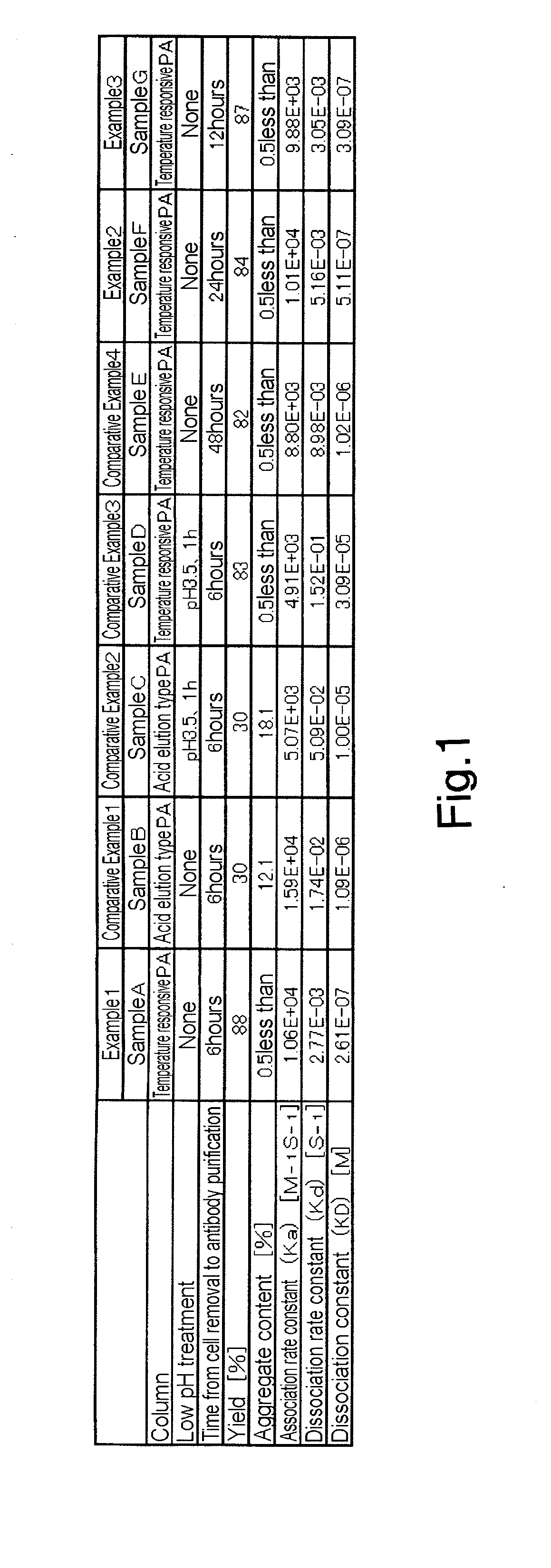High-affinity antibody and method for manufacturing the same
a high-affinity, antibody technology, applied in the field of purification methods, can solve the problems of reducing the affinity of antigens in view of virus safety, reducing the inherent affinity of antibodies for antigens, and reducing the affinity of antigens, etc., to achieve high purity and high yield
- Summary
- Abstract
- Description
- Claims
- Application Information
AI Technical Summary
Benefits of technology
Problems solved by technology
Method used
Image
Examples
example 1
Preparation of Temperature Responsive Protein a Medium
[0081]After a carboxyl group was introduced into crosslinked polyvinyl alcohol beads, the carboxyl group was activated by NHS. Furthermore, the crosslinked polyvinyl alcohol beads activated by NHS were brought into contact with temperature responsive protein A to immobilize temperature responsive protein A to the crosslinked polyvinyl alcohol beads. The procedure is more specifically as follows.
[0082]1) Introduction of Carboxyl Group
[0083]A reaction solution was prepared by dissolving succinic anhydride (3.0 g) and 4-dimethylaminopyridine (3.6 g) in toluene (450 mL). Then, crosslinked polyvinyl alcohol beads (average particle size 100 μm) (7.5 mL), which were prepared in accordance with the method described in Example 1 of Japanese Patent Laid-Open No. 59-17354, were brought into contact with the reaction solution at 50° C. and stirred for 2 hours. In this manner, a carboxyl group was introduced into the crosslinked polyvinyl alc...
example 2
[0147]AE6F4 production cells were cultured and a culture supernatant was obtained. Twenty four hours later, a solution containing an antibody was poured in the temperature responsive protein A column to have the medium adsorb the antibody. The same procedure as in Example 1 was repeated except the above conditions to purify AE6F4 antibody, which was specified as sample F.
[0148]The antibody of sample F was measured for affinity in the same manner as in Example. The dissociation constant (KD value) of sample F was 5.11×10−7 [M], which was smaller than the values of Comparative Examples. Other measurement values are shown in FIG. 1.
example 3
[0149]AE6F4 production cells were cultured and a culture supernatant was obtained. Twelve hours later, a solution containing an antibody was poured in the temperature responsive protein A column to have the medium adsorb the antibody. The same procedure as in Example 1 was repeated except the above conditions to purify AE6F4 antibody, which was specified as sample G.
[0150]The antibody of sample G was measured for affinity in the same manner as in Example. The dissociation constant (KD value) of sample G was 3.09×10−7 [M], which was smaller than the values of Comparative Examples. Other measurement values are shown in FIG. 1.
PUM
| Property | Measurement | Unit |
|---|---|---|
| temperature | aaaaa | aaaaa |
| diameter | aaaaa | aaaaa |
| diameter | aaaaa | aaaaa |
Abstract
Description
Claims
Application Information
 Login to View More
Login to View More - R&D
- Intellectual Property
- Life Sciences
- Materials
- Tech Scout
- Unparalleled Data Quality
- Higher Quality Content
- 60% Fewer Hallucinations
Browse by: Latest US Patents, China's latest patents, Technical Efficacy Thesaurus, Application Domain, Technology Topic, Popular Technical Reports.
© 2025 PatSnap. All rights reserved.Legal|Privacy policy|Modern Slavery Act Transparency Statement|Sitemap|About US| Contact US: help@patsnap.com

